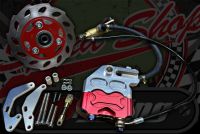Featured Product

Brake disc kit. Rear. Conversion. Suitable for Monkey bike running 8" or 10" wheels powerful 4 pot
£179.99 £149.99 ExVATBest Sellers
- Sprocket. Front. 420 pitch. 17mm spline. Off set 7mm or 15mm. 16T
£21.31 £17.76 ExVAT - Sprocket. Component. Spacer. Rear. 7mm or 15mm offset. Suitable for Monkey bike
£15.98 £13.32 ExVAT - Stainless 304 exhaust/inlet pipe bends 90 degree Sizes OD from 19mm to 76mm
£3.46 £2.88 ExVAT - CDI. BOLT Easy Start Digital 3 in one 5 6C 6H PIN Built in switchable adjustable rev control or full power
£23.99 £19.99 ExVAT - Stainless 304 exhaust/inlet pipe bends 45 degree Sizes OD from 19mm to 76mm
£3.02 £2.52 ExVAT - Stainless polished 304 tube. Sizes OD from 19mm to 76mm. 1 metre lengths.
£7.14 £5.95 ExVAT - Jet. Main. Mikuni. VM/TM fit. Hex. 90 to 240 in increments of 10
£4.00 £3.33 ExVAT - Jet. Pilot. VM26, Mikuni, Molkt and Dirtmax, 15.0 to 37.5 for VM26 Mikuni & Dirtmax/Molk Carbs. 15.0 to 37.5 in increments of 2.5
£4.99 £4.16 ExVAT - Air filter STACK. Z190 50mm fitting 35mm long with foam and gauze option
£13.20 £11.00 ExVAT - Sprocket. Front. 420 pitch. 17mm spline. 10T-18T
£6.98 £5.82 ExVAT - Spark plug. NGK. C6HSA, CR7HSA C7HSA, C8HSA
£4.06 £3.38 ExVAT - Inner tube. All common sizes. 8" to 18"
£10.00 £8.33 ExVAT - CDI. 4 Pin. Easy Start Digital . D/C. Performance Unit. SS3 3 PHASE.
£19.99 £16.66 ExVAT - Gasket. Exhaust. 33mm O/D. Fits all engines
£1.50 £1.25 ExVAT - Sprocket. Rear. 420 or 428 pitch. SDG. 30T to 42T
£26.00 £21.67 ExVAT - Block connectors 2, 3, 4, 6, 9 pin
£0.67 £0.56 ExVAT - Manifold. Component. Gasket. Head to manifold. Intake. Choice of 20mm to 28mm
£1.15 £0.96 ExVAT - Gen kit. Full ignition system. Race VMR118
£87.60 £73.00 ExVAT - Sprocket. Rear. 420 pitch. 3 bolt. Suitable for monkey. 420 pitch. 23T to 45T
£14.99 £12.49 ExVAT - Side panel. Oval. Full range of colours. Suitable for Monkey bike
£14.99 £12.49 ExVAT
On Sale
- Stand. Bike Fast rise for pit bikes CNC light weight alloy
£58.99 £16.67 - Exhaust. Complete. Twin. Budget system. Suitable for use with Monkey bikes
£99.00 £74.00 - Tyre. Sava/MITA. MC0. 3.50" X 10". Race. Slicks.
£49.99 £25.00 - Seat Baja style RED or BLACK
£41.65 £33.32 - Tank. Steel. Suitable for Gorilla.
£38.00 £30.00 - Mudguard. Fender. Splash guard. Enduro. Universal
£9.99 £4.15 - Handlebars. Clamp. Cast alloy. Fits folding bars. Standard replacement
£13.33 £7.49 - 22mm Shengwei/Keikhinkt! Carb PB style C90 Fuel tap or Non fuel tap
£22.49 £17.00 - Head lamp brackets classic style flasher mounts
£12.49 £10.00 - Sticker set. 25 pieces. 23cm x 26cm. Decal. Decals
£1.99 £1.66
